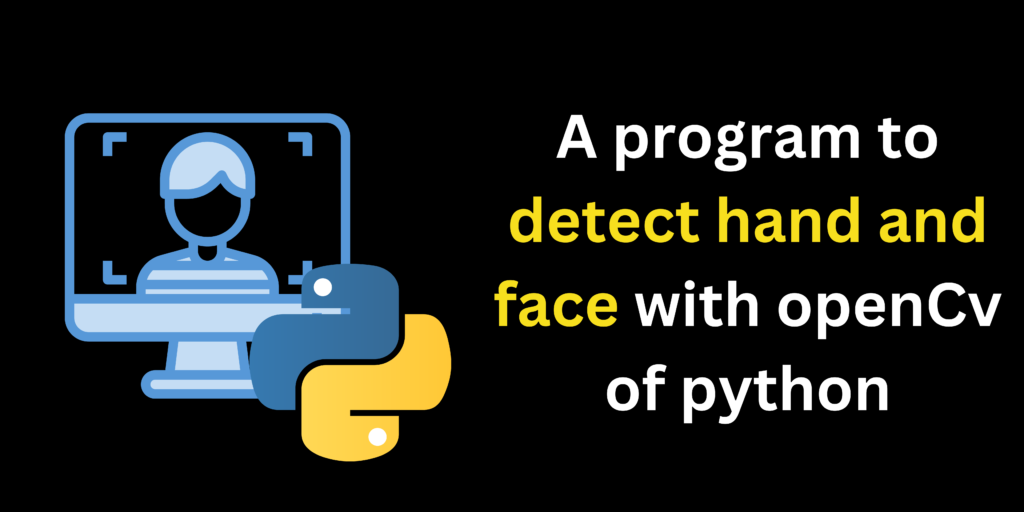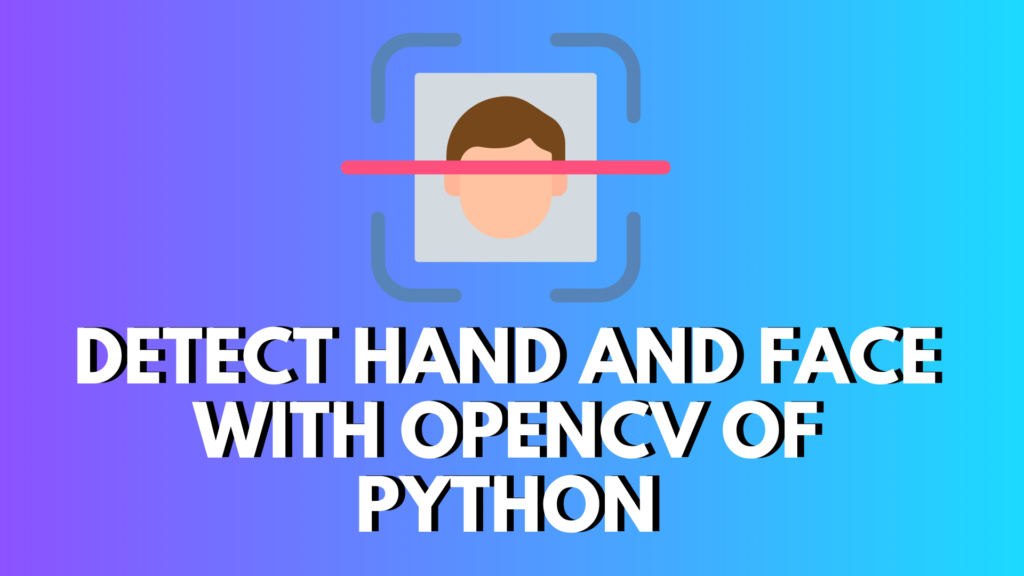
Introduction
A program to detect hand and face with openCv of python. OpenCV (Open Source Computer Vision Library) is an open-source computer vision and machine learning software library that can be used to develop real-time computer vision applications. In Python, OpenCV provides a number of functions that make it easy to detect faces and hands in images and video streams.
Hand detection OpenCV python code
MediaPipe
Hand gesture recognition Python GitHub
Hand detection Python
Hand detection Python GitHub
MediaPipe hand gesture recognition
hand-detection github
OpenCV hand gesture recognition
detect hand and face with openCv
To get started with face and hand detection using OpenCV in Python, you will need to install the OpenCV library using pip. You can do this by opening a terminal window and entering the following command:
pip install opencv-python
Once you have installed OpenCV, you can create a Python script to detect faces and hands in an image or video stream. Here is an example program that demonstrates how to detect faces and hands using OpenCV in Python:
import cv2
# Load the cascade for detecting faces and hands
face_cascade = cv2.CascadeClassifier('haarcascade_frontalface_default.xml')
hand_cascade = cv2.CascadeClassifier('hand.xml')
# Open the camera
cap = cv2.VideoCapture(0)
while True:
# Read the frame from the camera
ret, frame = cap.read()
# Convert the frame to grayscale
gray = cv2.cvtColor(frame, cv2.COLOR_BGR2GRAY)
# Detect faces
faces = face_cascade.detectMultiScale(gray, 1.3, 5)
# Draw rectangles around each face
for (x,y,w,h) in faces:
cv2.rectangle(frame,(x,y),(x+w,y+h),(255,0,0),2)
# Detect hands
hands = hand_cascade.detectMultiScale(gray, 1.3, 5)
# Draw rectangles around each hand
for (x,y,w,h) in hands:
cv2.rectangle(frame,(x,y),(x+w,y+h),(0,255,0),2)
# Display the resulting frame
cv2.imshow('frame',frame)
# Exit if the user presses 'q'
if cv2.waitKey(1) & 0xFF == ord('q'):
break
# Release the capture and close the window
cap.release()
cv2.destroyAllWindows()

1. Hand Gesture Recognition in Python
Hand gesture recognition can be done using OpenCV and MediaPipe. OpenCV is a powerful library for image processing, while MediaPipe provides a specialized Hand Tracking module that detects hands efficiently.
Code for Hand Gesture Recognition using MediaPipe
import cv2
import mediapipe as mp
# Initialize MediaPipe Hands module
mp_hands = mp.solutions.hands
mp_drawing = mp.solutions.drawing_utils
hands = mp_hands.Hands(min_detection_confidence=0.7, min_tracking_confidence=0.7)
# Open webcam
cap = cv2.VideoCapture(0)
while cap.isOpened():
ret, frame = cap.read()
if not ret:
break
# Convert to RGB
rgb_frame = cv2.cvtColor(frame, cv2.COLOR_BGR2RGB)
results = hands.process(rgb_frame)
# Draw landmarks if hands are detected
if results.multi_hand_landmarks:
for hand_landmarks in results.multi_hand_landmarks:
mp_drawing.draw_landmarks(frame, hand_landmarks, mp_hands.HAND_CONNECTIONS)
cv2.imshow("Hand Gesture Recognition", frame)
# Exit on pressing 'q'
if cv2.waitKey(1) & 0xFF == ord('q'):
break
cap.release()
cv2.destroyAllWindows()
Explanation
- MediaPipe Hands detects hand landmarks in real-time.
- The video feed is captured using OpenCV.
- The hand landmarks are detected and drawn on the video.
- The window updates continuously, displaying the detected hand movements.
2. How to Track Hand in Python?
Tracking a hand means continuously detecting its position and movement. We can use MediaPipe Hands for this purpose.
Code for Hand Tracking
import cv2
import mediapipe as mp
mp_hands = mp.solutions.hands
mp_drawing = mp.solutions.drawing_utils
hands = mp_hands.Hands(min_detection_confidence=0.7, min_tracking_confidence=0.7)
cap = cv2.VideoCapture(0)
while cap.isOpened():
ret, frame = cap.read()
if not ret:
break
rgb_frame = cv2.cvtColor(frame, cv2.COLOR_BGR2RGB)
results = hands.process(rgb_frame)
if results.multi_hand_landmarks:
for hand_landmarks in results.multi_hand_landmarks:
mp_drawing.draw_landmarks(frame, hand_landmarks, mp_hands.HAND_CONNECTIONS)
# Get the coordinates of the index finger tip
index_finger_tip = hand_landmarks.landmark[mp_hands.HandLandmark.INDEX_FINGER_TIP]
h, w, _ = frame.shape
cx, cy = int(index_finger_tip.x * w), int(index_finger_tip.y * h)
# Draw a circle on the index finger tip
cv2.circle(frame, (cx, cy), 10, (0, 255, 0), -1)
cv2.imshow("Hand Tracking", frame)
if cv2.waitKey(1) & 0xFF == ord('q'):
break
cap.release()
cv2.destroyAllWindows()
Explanation
- We track index finger movement by detecting the coordinates of the INDEX_FINGER_TIP landmark.
- The coordinates are mapped onto the webcam feed.
- This can be used for applications like virtual mouse control or gesture-based interfaces.
3. Difference Between OpenCV and MediaPipe
| Feature | OpenCV | MediaPipe |
|---|---|---|
| Purpose | General image processing | Specialized AI models for real-time processing |
| Ease of Use | Requires manual feature extraction | Pretrained models for face, hand, and body tracking |
| Performance | Slower for deep learning tasks | Optimized for mobile & real-time tracking |
| Gesture Recognition | Requires training a model | Pre-trained hand tracking model |
Key Takeaway:
- Use OpenCV for general image processing tasks.
- Use MediaPipe for real-time hand detection, face tracking, and pose estimation.
4. How to Do Hand Detection?
Hand detection involves identifying the presence of a hand in an image or video.
Code for Hand Detection Using OpenCV and MediaPipe
import cv2
import mediapipe as mp
mp_hands = mp.solutions.hands
mp_drawing = mp.solutions.drawing_utils
hands = mp_hands.Hands(min_detection_confidence=0.5, min_tracking_confidence=0.5)
cap = cv2.VideoCapture(0)
while cap.isOpened():
ret, frame = cap.read()
if not ret:
break
rgb_frame = cv2.cvtColor(frame, cv2.COLOR_BGR2RGB)
results = hands.process(rgb_frame)
if results.multi_hand_landmarks:
cv2.putText(frame, "Hand Detected", (50, 50), cv2.FONT_HERSHEY_SIMPLEX, 1, (0, 255, 0), 2)
cv2.imshow("Hand Detection", frame)
if cv2.waitKey(1) & 0xFF == ord('q'):
break
cap.release()
cv2.destroyAllWindows()
Explanation
- The program detects if a hand is present in the webcam feed.
- If a hand is detected, the message “Hand Detected” is displayed on the screen.
What Algorithm Is Used for Hand Gesture Recognition?
Hand gesture recognition typically relies on Deep Learning, Computer Vision, and Feature Extraction techniques. The most commonly used algorithms include:
| Algorithm | Description |
|---|---|
| CNN (Convolutional Neural Networks) | Used to classify hand gestures by analyzing image features. |
| MediaPipe Hands | Uses a pre-trained deep learning model for real-time hand tracking and landmark detection. |
| HOG (Histogram of Oriented Gradients) | Extracts edge features for gesture recognition. |
| SVM (Support Vector Machine) | Classifies hand gestures based on extracted features. |
| RNN (Recurrent Neural Networks) & LSTMs | Used for recognizing dynamic gestures in videos. |
| YOLO (You Only Look Once) | Fast object detection model used for real-time gesture detection. |
How Do You Train a Model for Hand Gesture Recognition?
To train a model, follow these steps:
Step 1: Collect Data
- Capture images/videos of different gestures (e.g., thumbs up, victory sign, open palm).
- Store images in separate folders for each gesture class.
Step 2: Preprocess Data
- Resize images to a fixed dimension (e.g., 64×64 pixels).
- Convert to grayscale or normalize pixel values.
- Augment data (rotation, flipping) to increase variability.
Step 3: Train a CNN Model in Python
Here’s a simple CNN model using TensorFlow/Keras:
import tensorflow as tf
from tensorflow.keras.models import Sequential
from tensorflow.keras.layers import Conv2D, MaxPooling2D, Flatten, Dense
from tensorflow.keras.preprocessing.image import ImageDataGenerator
# Data preprocessing
train_datagen = ImageDataGenerator(rescale=1./255)
train_data = train_datagen.flow_from_directory("dataset/train", target_size=(64,64), batch_size=32, class_mode='categorical')
# Build CNN model
model = Sequential([
Conv2D(32, (3,3), activation='relu', input_shape=(64,64,3)),
MaxPooling2D(pool_size=(2,2)),
Conv2D(64, (3,3), activation='relu'),
MaxPooling2D(pool_size=(2,2)),
Flatten(),
Dense(128, activation='relu'),
Dense(5, activation='softmax') # 5 gesture classes
])
# Compile & Train
model.compile(optimizer='adam', loss='categorical_crossentropy', metrics=['accuracy'])
model.fit(train_data, epochs=10)
model.save("gesture_model.h5")
Step 4: Test the Model
import cv2
import numpy as np
from tensorflow.keras.models import load_model
model = load_model("gesture_model.h5")
def predict_gesture(image):
image = cv2.resize(image, (64,64))
image = np.expand_dims(image, axis=0) / 255.0
prediction = model.predict(image)
return np.argmax(prediction)
cap = cv2.VideoCapture(0)
while cap.isOpened():
ret, frame = cap.read()
if not ret:
break
gesture_class = predict_gesture(frame)
cv2.putText(frame, f"Gesture: {gesture_class}", (50,50), cv2.FONT_HERSHEY_SIMPLEX, 1, (0,255,0), 2)
cv2.imshow("Gesture Recognition", frame)
if cv2.waitKey(1) & 0xFF == ord('q'):
break
cap.release()
cv2.destroyAllWindows()
How Do You Show Gestures in Writing?
Gestures can be represented in writing using descriptive text, symbols, or ASL notation:
- Descriptive Text:
- “He raised his hand in a wave.”
- “She gave a thumbs-up sign.”
- Emoji Symbols:
- 👍 (Thumbs up)
- ✌️ (Victory sign)
- ASL (American Sign Language) Notation:
- “G” (Fist with extended index and thumb for ‘G’ in ASL)
- “L” (Thumb and index finger forming an ‘L’)
How Can Gestures Be Used as Symbols?
Gestures are visual symbols that convey meaning across cultures, often replacing spoken language.
- Universal Symbols:
- 👍 → “Good/Approval”
- 👎 → “Bad/Disapproval”
- ✌️ → “Peace/Victory”
- 🤟 → “I Love You” in ASL
- Cultural Meanings:
- 🙏 (Hands pressed together) → Praying in some cultures, greeting in others.
- 👌 (OK sign) → Approval in Western culture but offensive in some countries.
- Gesture-Based Interfaces:
- In Gaming: Kinect or VR hand tracking allows players to control characters.
- In Technology: Touchless UI uses gestures for navigation (e.g., swipe hand to change slides).
Would you like to implement gesture-controlled applications, such as a virtual mouse or sign language recognition? 🚀
Conclusion
To sum up, OpenCV in Python has robust features for detecting faces and hands in images and videos. It uses sophisticated computer vision algorithms such as Haar cascades and HOG to precisely identify and follow facial features and hand movements. This technology has diverse applications, including security systems, gesture-based interfaces, and virtual reality environments. Moreover, OpenCV is user-friendly and comes with extensive documentation, making it a great choice for developing computer vision applications in Python.




0 Comments